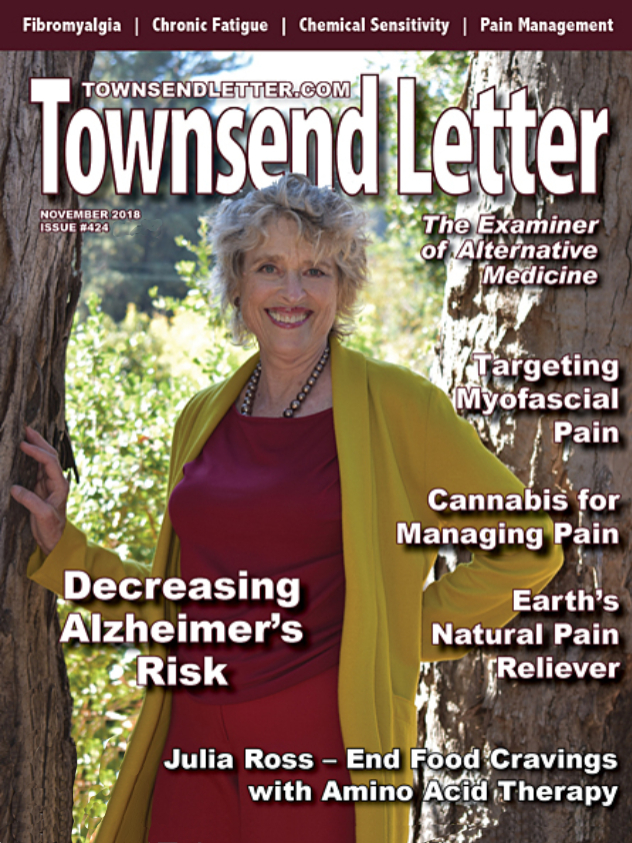
November 2018
Issue #424
Letter from the Publisher
by Jonathan Collin, MD
The Coffee Recommended for People with Chemical Sensitivities
Steven Helschien, DC
Most commercial coffees contain chemicals, molds, and mycotoxins that compromise the health benefits of this superfood. This article offers an alternative.
Cellular and Mitochondrial Support in the Fatigued Patient
Paul S. Anderson, NMD
Nutrient-based support for oxidation-reduction reactions and for mitochondrial function can aid cellular balance and help patients recover from fatigue.
- 20 Years of Psychosomatic Energetics – A Retrospective
Dr. Reimar Banis
Long-held emotional conflicts and trauma eventually produce energy blockages. Psychosomatic Energetics acts to dissolve the blockages, freeing energetic obstacles and releasing energy for healing.
New Hope for Alzheimer’s Disease, Part 2: Understanding Folate, B12, and Homocysteine
James Greenblatt, MD
Part 1 discussed the use of lithium to protect against neuropathological deterioration. This article looks at altering two modifiable risk factors for Alzheimer’s disease – decreasing homocysteine and increasing B vitamins.
- Effective Treatment of Pain and Sleep in Fibromyalgia – A Comprehensive Clinical Approach
Jacob Teitelbaum, MD
A recognized expert on fibromyalgia and related conditions discusses medications and natural options for treating sleep problems and pain.
Drug Addiction, Pain Control, and Cure
Reagan Houston
High doses of vitamin C can relieve pain and is useful in treating drug addiction, as it attaches to the same receptors on cells as opiates/narcotics.
Application of the Restoration Model in Today’s Medical Practice
Jean-Ronel Corbier, MD, and Paul Corbier, MD
This follow-up to a December 2017 article outlines tools used in this wholistic, individualized approach to healing and restoration.
- The Craving Cure: The Nutritional Solution to Our Worldwide Dietary Crisis
Julia Ross
For over 30 years, Julia Ross has pioneered the use of nutritional therapies to treat mood disorders, eating disorders, and addiction. Individualized amino acid therapy addressing five possible targets of addictive foods allows people to regain control over the craving and make healthful food choices. This article draws on information from her latest book, The Craving Cure.
Underappreciated Risks in Pain Management
Robert Gorter, MD, PhD
Pharmaceuticals and over-the-counter analgesics used to treat pain have adverse health effects that often create the need for more drugs with their own side effects. Cannabis provides a safe alternative or complement, resulting in reduced opioid use.
- Cannabis in Pain Management
Robert Gorter, MD, PhD
Cannabis contains multiple components that produce pain relief. Used alone or in combination with opioids, less opioids are needed for pain relief, reducing the risk of side effects, addiction, and overdose.
- Endocannabinoids, Phytocannabinoids, Palmitoylethanolamide and Their Fascinating Role in Pain Management
Chris D. Meletis, ND, and Kimberly Wilkes
Cannabinoids and palmitoylethanolamide (PEA) offer alternatives to conventional care for chronic pain due to neuropathy, joint problems, and other pain disorders.
- Rx: Earth – The Original Painkiller!
Exploiting the Planet’s Natural Anti-Inflammatory Power for Pain Relief
James L. Oschman, PhD, Stephen T. Sinatra, MD, Gaétan Chevalier, PhD, and Martin Zucker
Earthing, or biological grounding, causes a rapid influx of electrons into the body, resulting in reduced inflammation and improved autonomic nervous system balance.
- The Truth About Pain – A Different Paradigm
Hal S. Blatman, MD
Trained as an orthopedic surgeon, this specialist in myofascial pain urges a different way of handling musculoskeletal pain, based on fascial injury.
Columns
Pathways to Healing
How to Live With and Move Beyond Chronic Pain
Elaine Zablocki
Shorts
Jule Klotter
Literature Review & Commentary
Alan R. Gaby, MD
Healing with Homeopathy
Homeopathy for Refugee Trauma
Judyth Reichenberg-Ullman, ND, MSW; and Robert Ullman, ND
Ask Dr. J
There’s Somebody Inside My Body, But It’s Not Me
Jim Cross, ND, LAc
- Curmudgeon’s Corner
Primum Non Nocere meets Johnson et al
Jacob Schor, ND, FABNO
Editorial
The Influence of Dietary Factors on Fibromyalgia
Alan Gaby, MD
News
- Cancer Cell Growth Halted with Cold and Flu Drug
- Honor Whiteman
- Vitamin C Kills Cancer Stem Cells
In Memoriam
William James Rea, MD
Book Reviews
Fibro Fix
by David Brady, MD
review by Katherine Duff
The Craving Cure
by Julia Ross
review by William L. Wilson, MD
Book Excerpt
Chronic Fatigue Syndrome and Myalgic Encephalitis:
It’s Mitochondria, not Hypochondria
by Dr. Sarah Myhill, MB, BS



